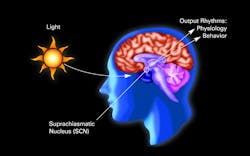Circadian ZircLight (sometimes referred to as Circadian Lighting) has announced the publication of new research focused on finding the precise range of blue wavelengths that impact the human circadian system. The knowledge of that range enables LED, lamp, and luminaire developments that can eliminate the identified range of spectral energy at night while activating the blue energy during the day using tunable solid-state lighting (SSL) techniques. The company asserts that the range of impactful blue wavelengths is much narrower than the circadian sensitivity curves published by earlier researchers.
The research entitled “Circadian potency spectrum with extended exposure to polychromatic white LED light under workplace conditions” was published in the Journal of Biological Rhythms on June 16, 2020. The research identifies a circadian sensitivity peak at 477 nm, and a FWHM (full width half maximum) range of 438–493 nm. Prior circadian sensitivity curves identified by Brainard, Thapan, and others have shown half-maximum sensitivity extending to shorter wavelengths in the violet region and to longer wavelengths in the green region. The narrower range identified by CircadianZircLight would make it simpler to develop blue-free SSL that still delivers top-quality color rendering using a pump in the violet-blue range.
Circadian ZircLight has pursued this theory of spectral sensitivity and different day and night spectral power distribution (SPD) going back several years. Indeed, company founder Dr. Martin Moore-Ede presented on the topic at our Lighting for Health and Wellbeing Conference back in 2018. The new research delivers the most comprehensive data on the topic to date.
The company has established its own Circadian Light Research Center to perform such research. “Our goal was to define the exact wavelengths of light that trigger the human circadian system in real-world lighting conditions,” said Moore-Ede. The company refers to the newly-defined waveband as Circadian Blue.
Moore-Ede has said before and emphasized with the new study that other research on circadian sensitivity and metrics has been conducted with research subjects in a dark-adapted state and with the use of monochromatic light. “At home and at work, we spend the vast majority of our time in a light-adapted state, exposed to white polychromatic light,” said Moore-Ede. “Our study reflects how we interact with light in the real world.”
The study involved 34 volunteers that were exposed to LED or fluorescent white-light spectra through 12-hour nights, with recurring melatonin level measurements throughout the exposure. The conditions emulated a night work shift. Over the course of the research, each participant was exposed to one of six polychromatic white LED SPDs and the fluorescent SPD on separate test nights. Light levels at the task plane were 540 lx in all of the test areas and representative of work light recommendations from organizations such as the Illluminating Engineering Society (IES).
“We found melatonin suppression levels varied widely depending on the light source’s unique spectral characteristics,” said Dr. Anneke Heitman, a study co-author. “This data enabled us to isolate the impact of individual wavelengths of light and determine the color of Circadian Blue.”
The research will be leveraged to support the company’s offer of what it calls Zirc LEDs with different versions spectrally engineered for day or night use. The day LED includes the blue energy that has been shown to boost alertness. The company has already licensed the technology to Acuity Brands and H.E. Williams.
Circadian ZircLight is not the only company to offer blue-free or blue-depleted SSL technology. Soraa contributed an article to our publication back in 2017 on BlueFree technology. Soraa also utilizes a violet pump in its proprietary LEDs. Soraa was acquired by Ecosense a few months back. Seoul Semiconductor also utilizes a violet pump in its SunLike LEDs.
You can peruse the Circadian paper for full details on the research. It details the melatonin measurement techniques, the test SPDs and more.
For up-to-the-minute LED and SSL updates, why not follow us on Twitter? You’ll find curated content and commentary, as well as information on industry events, webcasts, and surveys on our LinkedIn Company Page and our Facebook page.





